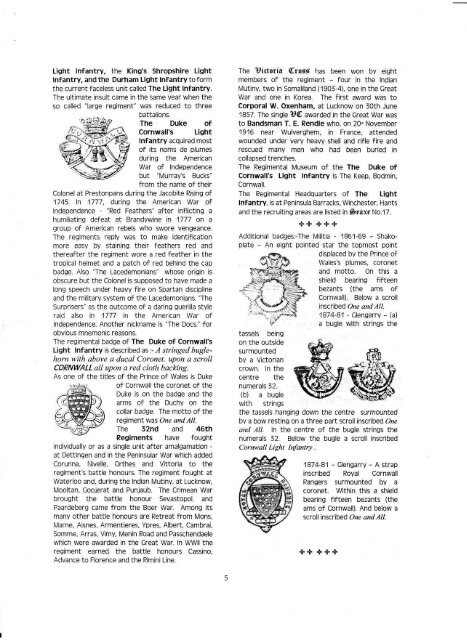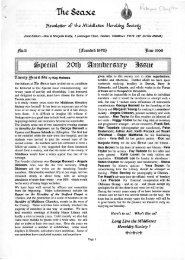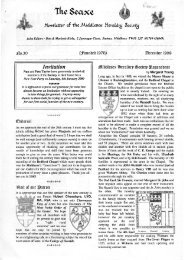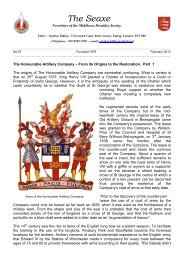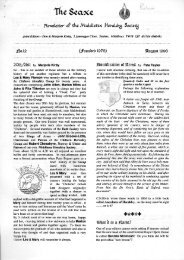The Seaxe - Middlesex Heraldry Society
The Seaxe - Middlesex Heraldry Society
The Seaxe - Middlesex Heraldry Society
You also want an ePaper? Increase the reach of your titles
YUMPU automatically turns print PDFs into web optimized ePapers that Google loves.
Light Infantry, the King's Shropshire Light<br />
Infantry, and the Durham Light Infantry to form<br />
the current faceless unit called <strong>The</strong> Light Infantry.<br />
<strong>The</strong> ultimate insult came in the same year when the<br />
so called "large regiment" was reduced to three<br />
battalions.<br />
<strong>The</strong> Duke of<br />
Cornwall's Light<br />
Infantry acquired most<br />
of its noms de plumes<br />
during the American<br />
War of Independence<br />
but "Murray's Bucks"<br />
from the name of their<br />
Colonel at Prestonpans during the Jacobite Rising of<br />
1745. In 1777, during the American War of<br />
Independence - "Red Feathers" after inflicting a<br />
humiliating defeat at Brandywine in 1777 on a<br />
group of American rebels who swore vengeance.<br />
<strong>The</strong> regiments reply was to make identification<br />
more easy by staining their feathers red and<br />
thereafter the regiment wore a red feather in the<br />
tropical helmet and a patch of red behind the cap<br />
badge. Also "<strong>The</strong> Lacedemonians" whose origin is<br />
obscure but the Colonel is supposed to have made a<br />
long speech under heavy fire on Spartan discipline<br />
and the military system of the Lacedemonians. "<strong>The</strong><br />
Surprisers" as the outcome of a daring guerilla style<br />
raid also in 1777 in the American War of<br />
Independence. Another nickname is "<strong>The</strong> Docs." for<br />
obvious mnemonic reasons.<br />
<strong>The</strong> regimental badge of <strong>The</strong> Duke of Cornwall's<br />
Light Infantry is described as :- A stringed buglehorn<br />
with above a ducal Coronet, upon a scroll<br />
CORNWALL all upon a red cloth backing.<br />
As one of the titles of the Prince of Wales is Duke<br />
of Cornwall the coronet of the<br />
Duke is on the badge and the<br />
arms of the Duchy on the<br />
collar badge. <strong>The</strong> motto of the<br />
regiment was One and All.<br />
<strong>The</strong> 32nd and 46th<br />
Regiments have fought<br />
individually or as a single unit after amalgamation -<br />
at Dettingen and in the Peninsular War which added<br />
Corunna, Nivelle, Orthes and Vittoria to the<br />
regiment's battle honours. <strong>The</strong> regiment fought at<br />
Waterloo and, during the Indian Mutiny, at Lucknow,<br />
Mooltan, Goojerat and Punjaub. <strong>The</strong> Crimean War<br />
brought the battle honour Sevastopol, and<br />
Paardeberg came from the Boer War. Among its<br />
many other battle honours are Retreat from Mons,<br />
Marne, Aisnes, Armentieres, Ypres, Albert, Cambrai,<br />
Somme, Arras, Vimy, Menin Road and Passchendaele<br />
which were awarded in the Great War. In WWII the<br />
regiment earned the battle honours Cassino,<br />
Advance to Florence and the Rimini Line.<br />
5<br />
<strong>The</strong> Victoria Cross has been won by eight<br />
members of the regiment - four in the Indian<br />
Mutiny, two in Somaliland (1903-4), one in the Great<br />
War and one in Korea. <strong>The</strong> first award was to<br />
Corporal W. Oxenham, at Lucknow on 30th June<br />
1857. <strong>The</strong> single VC awarded in the Great War was<br />
to Bandsman T. E. Rendle who, on 20thNovember<br />
1916 near Wulverghem, in France, attended<br />
wounded under very heavy shell and rifle fire and<br />
rescued many men who had been buried in<br />
collapsed trenches.<br />
<strong>The</strong> Regimental Museum of the <strong>The</strong> Duke of<br />
Cornwall's Light Infantry is <strong>The</strong> Keep, Bodmin,<br />
Cornwall.<br />
<strong>The</strong> Regimental Headquarters of <strong>The</strong> Light<br />
Infantry, is at Peninsula Barracks, Winchester, Hants<br />
and the recruiting areas are listed in <strong>Seaxe</strong> No.17.<br />
+ + + + +<br />
Additional badges:-<strong>The</strong> Militia - 1861-69 - Shakoplate<br />
- An eight pointed star the topmost point<br />
displaced by the Prince of<br />
Wales's plumes, coronet<br />
and motto. On this a<br />
shield bearing fifteen<br />
bezants (the arms of<br />
Cornwall). Below a scroll<br />
inscribed One and All.<br />
1874-81 - Glengarry - (a)<br />
a bugle with strings the<br />
tassels being<br />
on the outside<br />
surmounted<br />
by a Victorian<br />
crown. In the<br />
centre the<br />
numerals 32.<br />
(b) a bugle<br />
with strings<br />
the tassels hanging down the centre surmounted<br />
by a bow resting on a three part scroll inscribed One<br />
and All. In the centre of the bugle strings the<br />
numerals 32. Below the bugle a scroll inscribed<br />
Cornwall Light Infantry.<br />
1874-81 - Glengarry - A strap<br />
inscribed Royal Cornwall<br />
Rangers surmounted by a<br />
coronet. Within this a shield<br />
bearing fifteen bezants (the<br />
arms of Cornwall). And below a<br />
scroll inscribed One and All.


